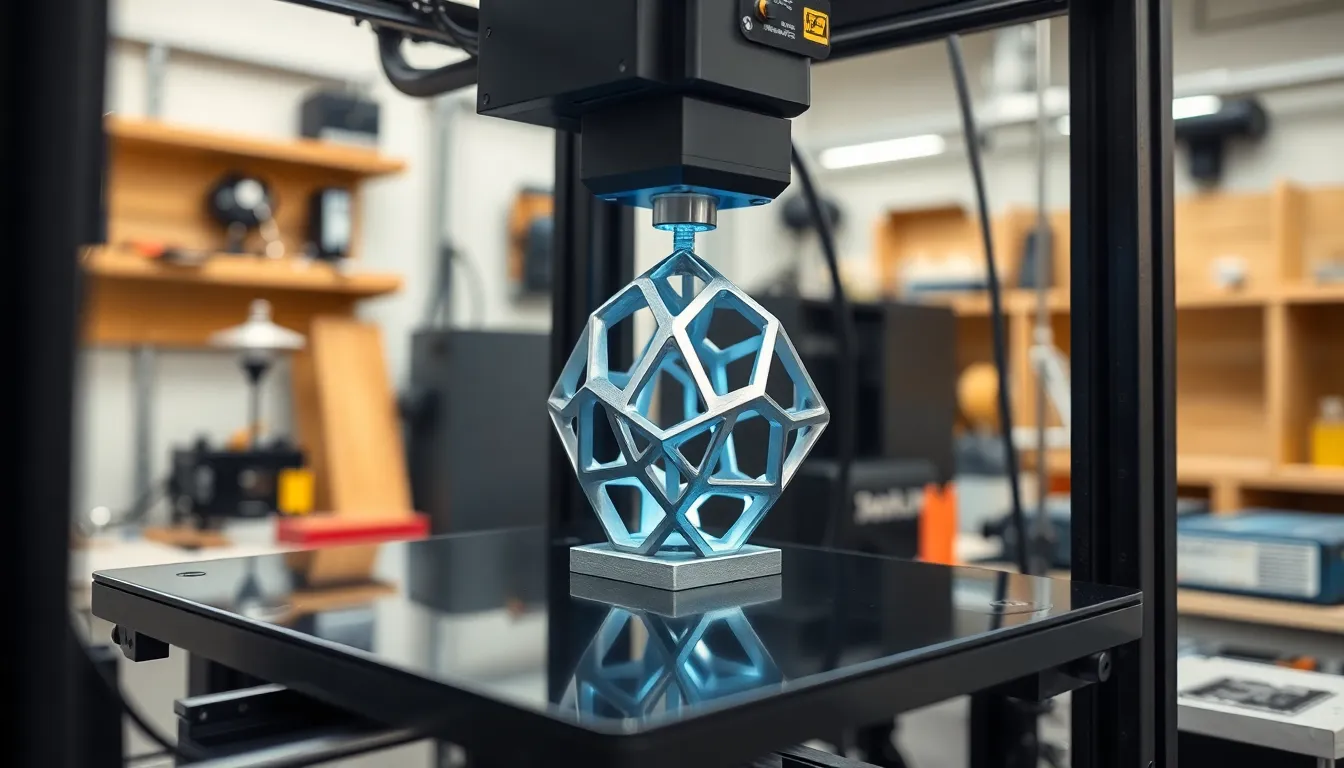In a world where everything seems to be getting lighter and more fragile, titanium marches in like a superhero clad in metal armor. This remarkable material, known for its strength and lightweight properties, is now taking the spotlight in the 3D printing arena. Imagine crafting intricate designs that can withstand the test of time—and the occasional rogue hammer.
Table of Contents
ToggleOverview of 3D Printing Titanium
3D printing titanium involves additive manufacturing techniques that layer material to create complex structures. This process allows for highly detailed designs that traditional methods struggle to achieve. Various techniques, such as Selective Laser Melting (SLM) and Electron Beam Melting (EBM), are commonly used in the industry, enhancing precision and efficiency.
Titanium’s low density combined with exceptional strength makes it desirable in aerospace, medical, and automotive sectors. Aerospace components benefit from titanium’s ability to withstand extreme temperatures while maintaining lightweight characteristics. In medical applications, titanium implants exhibit biocompatibility, ensuring patient safety and adaptability.
Understanding the properties of titanium is crucial for engineers and designers. It boasts excellent corrosion resistance, making parts durable and long-lasting. Thermal properties play a significant role, as titanium can endure high temperatures without deforming.
Factors influencing the 3D printing process include powder size, layer thickness, and printing speed. Smaller powder particles enhance the resolution of printed parts while optimizing layer thickness ensures structural integrity. Testing various printing speeds helps balance production time and quality results.
Applications of 3D printed titanium range from highly specialized items to everyday components. Manufacturers increasingly explore its potential for creating lightweight frames, intricate engine parts, and custom medical devices. The combination of strength, weight, and adaptability of titanium offers innovative solutions across multiple industries.
Sustainability is also a growing consideration. 3D printing titanium contributes to reduced material waste, as it uses only the necessary amount of material for production. Efforts to recycle titanium powder further enhance its eco-friendly profile in the manufacturing landscape.
Advantages of 3D Printing Titanium

3D printing titanium offers various advantages that enhance its appeal in multiple industries. This lightweight and robust material serves as an ideal choice for complex applications.
Lightweight and Strong
Titanium’s low density makes it significantly lighter than many metals. Aircraft components and medical implants benefit from this property, reducing overall weight while maintaining strength. Strength-to-weight ratios stand out, allowing for structures that endure intense conditions without compromising performance. Enhanced durability is another advantage, with titanium resisting deformation even under high stress. This combination leads to efficient designs that stand the test of time.
Design Flexibility
Design flexibility is a crucial benefit of 3D printing titanium. Additive manufacturing techniques enable the creation of intricate geometries that traditional methods struggle to achieve. Unique designs can incorporate complex internal structures, reducing material use and overall weight. Customization becomes easier, allowing manufacturers to tailor parts to specific needs. Rapid prototyping also speeds the design process, facilitating quick iterations without extensive delays. This adaptability meets the demands of diverse applications, from aerospace to medical devices.
Applications of 3D Printing Titanium
3D printing titanium plays a vital role across various industries, showcasing its versatility and benefits in practical applications. Key sectors include aerospace and medical devices, where titanium’s properties shine.
Aerospace Industry
Aerospace manufacturers utilize 3D printed titanium for lightweight structural components. Weight savings translate to significant fuel efficiency improvements, aligning with industry goals. Intricate designs, such as lattice structures, enhance performance and reduce material usage. Parts like brackets and engine components benefit from titanium’s high strength-to-weight ratio, enabling safe and reliable operations. Additionally, custom fittings and repairs can be made on-site, reducing lead times and costs. The ability to produce complex geometries also allows for innovative solutions, driving advancements in aircraft technology.
Medical Devices
3D printed titanium significantly impacts the medical field, especially in creating custom implants and prosthetics. Surgeons often require specific designs for unique patient anatomies, which titanium’s flexibility in manufacturing provides. Biocompatibility ensures successful integration into the human body, minimizing risks and enhancing patient outcomes. Notably, titanium implants exhibit resistance to corrosion, a crucial factor for long-term use. Dentists employ titanium for dental implants, and orthopedic specialists favor it for joint replacements. Each application leverages titanium’s durability and lightweight properties, making it a preferred choice in modern healthcare solutions.
Challenges in 3D Printing Titanium
3D printing titanium presents unique challenges that engineers and manufacturers must navigate. Cost concerns significantly impact adoption rates in various industries.
Cost Considerations
Titanium remains one of the most expensive materials for 3D printing. High prices stem from the sourcing, quality processing, and specialized equipment required. Manufacturing often incurs additional expenses due to energy-intensive printing processes. Numerous industries might hesitate to use titanium if they seek low-cost options. Budgets typically dictate material choices, leading some companies to explore cheaper alternatives despite titanium’s advantages.
Technical Limitations
Technical limitations also pose challenges in the 3D printing of titanium. Equipment for processes like Selective Laser Melting (SLM) and Electron Beam Melting (EBM) requires significant investment. Operators must possess specialized training to ensure precision and quality. Layer thickness and resolution affect the final product’s mechanical properties, with too thick layers leading to weaker structures. Each variable plays a crucial role in the successful production of complex designs. Understanding these limitations is vital for optimizing the titanium printing process.
Future Trends in 3D Printing Titanium
Emerging technologies are poised to redefine the 3D printing landscape for titanium. Advancements in machine learning enhance process optimization, allowing manufacturers to evaluate printing parameters in real time. Reduced printing costs are a key focus, as companies seek methods to make titanium more accessible in production.
Customization trends are growing in various industries. Unique applications in aerospace may lead to titanium parts tailored for specific aircraft designs, improving fuel efficiency. Personalized medical implants also continue to evolve, adapting to individual patient anatomies for better compatibility and performance.
Sustainability stands at the forefront of future developments. Efforts to improve recycling methods for titanium powder will promote a circular economy within manufacturing. This shift can minimize waste and support environmental initiatives.
Innovations in powder technology significantly influence material characteristics. Researchers are investigating new alloy compositions, enhancing properties like strength and corrosion resistance. Enhanced material properties can further expand titanium’s applications across sectors.
Greater integration of automation in 3D printing processes may also contribute to efficiency. This automation can reduce human error and boost productivity, leading to faster production times. Enhanced precision in printing will ensure the integrity of complex designs.
Factors such as regulatory changes will play a crucial role in driving adoption. Industries must navigate compliance standards and certifications, which influence the use of titanium in critical applications. As regulations evolve, titanium’s role in manufacturing might increase, streamlining processes and enhancing safety.
Anticipating these trends will be vital for companies looking to leverage titanium’s unique advantages in 3D printing. Understanding the market shifts can help stakeholders position themselves effectively for future growth and development.
Titanium’s emergence in the 3D printing realm marks a significant advancement in manufacturing capabilities. Its unique properties offer unparalleled strength and lightweight characteristics that cater to diverse industries. As companies navigate the challenges and costs associated with 3D printing titanium, the potential for innovation and customization remains vast.
The ongoing developments in technology and sustainability practices will further enhance titanium’s role in modern applications. By embracing these advancements, industries can unlock the full potential of titanium, driving efficiency and creativity in design. The future of 3D printing titanium looks promising, paving the way for groundbreaking solutions that meet the evolving demands of various sectors.




